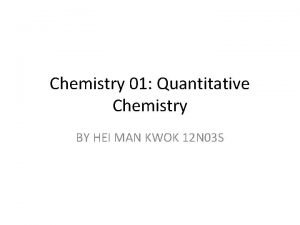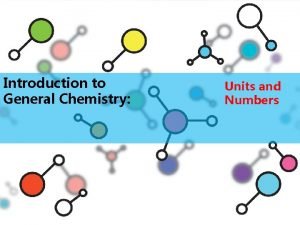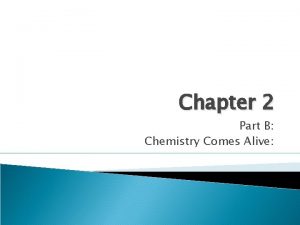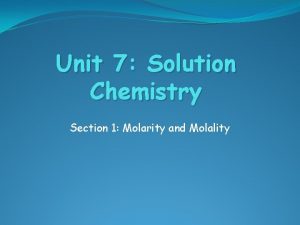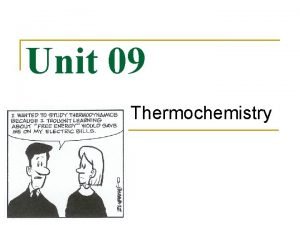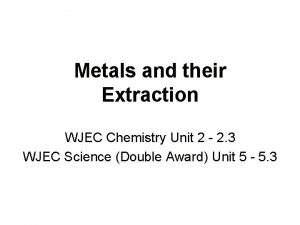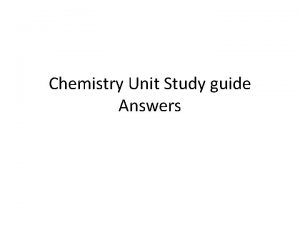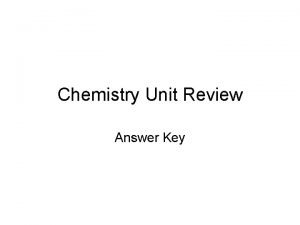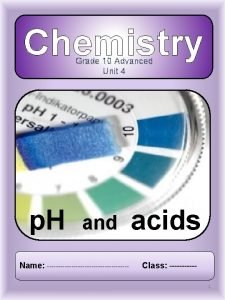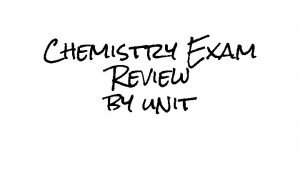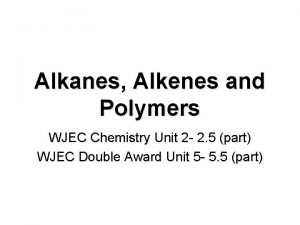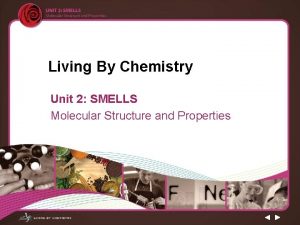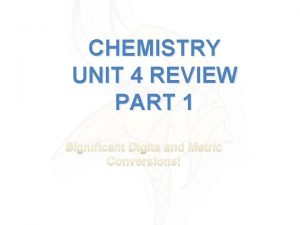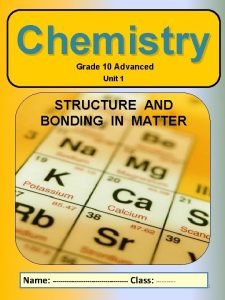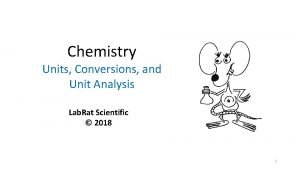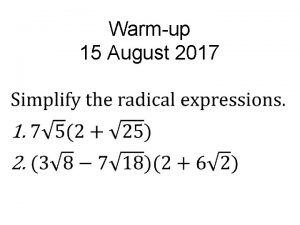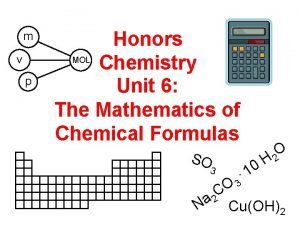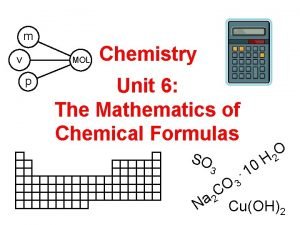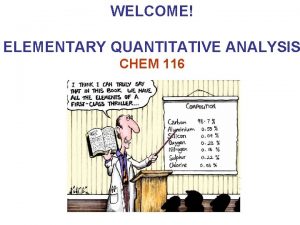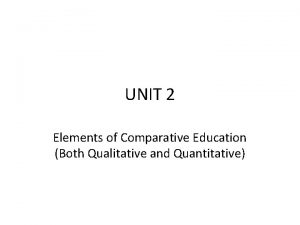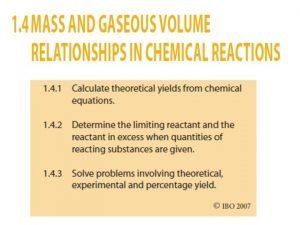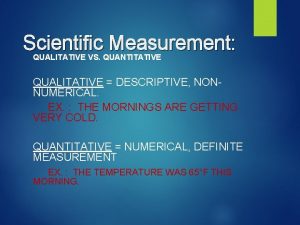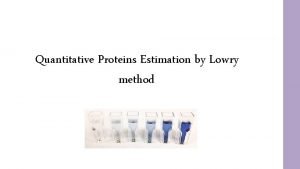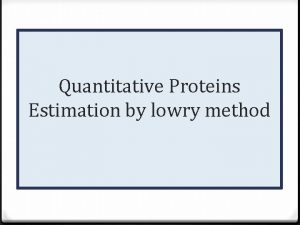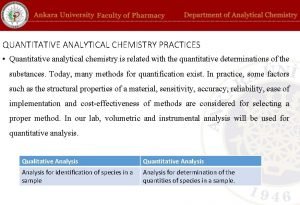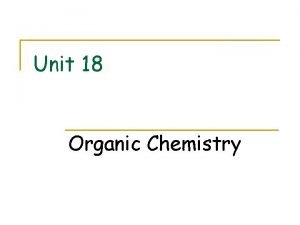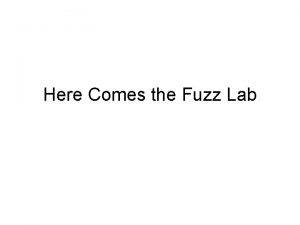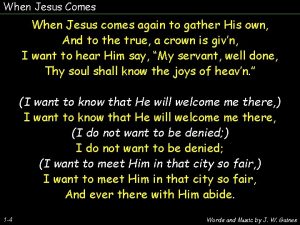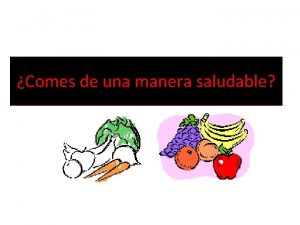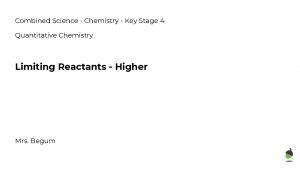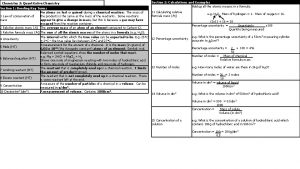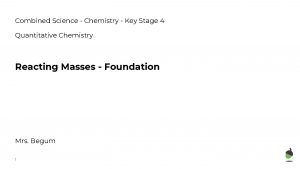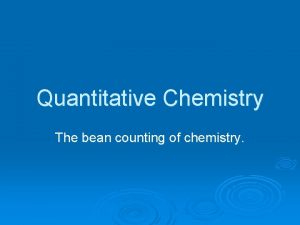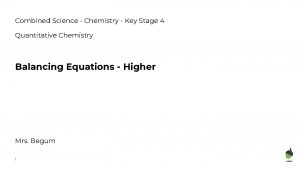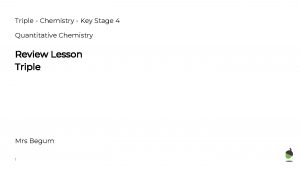UNIT 2 QUANTITATIVE CHEMISTRY I E IN COMES





































































- Slides: 69

UNIT 2 – QUANTITATIVE CHEMISTRY (I. E. IN COMES THE MATHS!! BRING A CALCULATOR!!)

Scientific Notation… A (very) brief introduction

Stoichiometry The study of the relationships between the quantities of reactants and products involved in chemical reactions. Stoikheion = element metron = measure

Proportions in compounds The composition of a compound depends on two things 1. The elements they are composed of 2. The quantities of each element.

Law of definite proportions A specific compound always contains the same elements in definite proportions by mass. This is always constant even if produced other ways.

Relative atomic mass and isotopic abundance (p 80) Relative atomic mass = the mass of an element that would react with a fixed mass of a standard element, currently carbon 12. One atomic mass unit (u) is described as 1/12 the mass of a carbon 12 atom.

Atomic mass unit Now we know that it weighs 1 u = 1. 660 540 2 x 10 27 kg. This is the standard used world wide

Isotopic abundance Some elements have isotopes. In calculating the relative atomic mass of an element with isotopes, the relative mass and proportion of each is taken into account. For example, naturally occurring carbon consists of atoms of relative isotopic masses C 12 (98. 89%) and C 13 (1. 11%). Its relative atomic mass is 12. 01 u.

Isotopic abundance mc = (98. 89/100 x 12) + (1. 11/100 x 13) = mc = 11. 8668 + 0. 1443 = 12. 01 u No atom will contain 12. 01 u. it is an average.

Example Cl 35 = 75. 53% Cl 37 = 24. 47% (35 x. 7553) + (37 x. 2447) = 35. 49 u Therefore the average atomic mass is 35. 49 u

Page 81 # 1

Atomic Mass and Molecular Mass Atomic Mass The mass of one atom of an element expressed in atomic units, u. Molecular mass The mass of one molecule, expressed in atomic mass units, u.

Example MNH 3 = 1(m. N) + 3(m. H) = 1(14. 01 u) + 3(1. 01 u) = 17. 04 u. Therefore, one molecule of ammonia has a mass of 17. 04 units.

Formula unit of mass The mass of one formula unit of an ionic compound, expressed in atomic mass units, u

Example Na. Cl = 1(m. Na) + 1(m. Cl) = 1 (22. 99 u) + 1(35. 45 u) = 58. 44 u Therefore, one formula unit of sodium chloride has a mass of 58. 44 units.

Page 81 # 1 -3

The Periodic Table and the Mass of Elements The atomic number of a substance is written near the top of the symbol. This number tells the number of protons in the element. The Atomic mass is usually written near the bottom. This number is given as a numerical number of the elements mass. The mass of one mole of the element measured in grams.

The Mole

It's not a spy, a machine for digging tunnels, a burrowing animal, or a spot of skin pigmentation it's a unit of measurement containing about 6. 02 x 1023 particles. Chemists created the mole as their own counting unit.

1 mole of atoms is 602, 214, 199, 000, 000 atoms! (This is the number of Carbon atoms there are in 12. 01 g or Carbon)

Avogadro’s Number 6. 02 x 1023 particles / mole When you say you have a mole, it’s kind of like saying you have ‘a dozen’ of something… A dozen donuts = 12 donuts A dozen apples = 12 apples A mole of CO 2 molecules = 6. 02 x 1023 molecules A mole of Na atoms = 6. 02 x 1023 atoms

Just How Big is a Mole? Enough soft drink cans to cover the surface of the earth to a depth of over 200 miles. If you had Avogadro's number of unpopped popcorn kernels, and spread them across the United States of America, the country would be covered in popcorn to a depth of over 9 miles. If we were able to count atoms at the rate of 10 million per second, it would take about 2 billion years to count the atoms in one mole.

Molar mass (g/mol) = M the mass, in grams per mole, of one mole of a substance. The SI unit for a mol is g/mol Molar mass is conventionally abbreviated with a capital M. For elements it is numerically equal to the atomic mass and is often called atomic mass units.

Steps to calculating molar mass 1. Write the chemical formula of the substance 2. Determine the number of atoms or ions of each element in one formula unit of the substance. 3. Us the atomic molar masses from the periodic table and the amounts in moles to determine the molar mass of the chemical 4. Write the molar mass in units of grams per mol (g/mol).

Example Molar mass of copper(Cu) = mass of 1 mol of Cu atoms M = 63. 546 g/mol Cu M = mass of 6. 022 x 10 23 atoms

Example 2 Molar mass of glucose (C 6 H 12 O 6) = mass of exactly 1 mol of glucose molecules M = (6 x C) + (12 x H) + ( 6 x O) M = ((6 x 12. 01 (C)) + (12 x 1. 01(H)) + (6 x 16. 00 (O)) ) / mol M = ( (72. 06 g) + (12. 12 g) + (96. 00 g) ) / mol M = ( 180. 18 g) / mol M = 180. 18 g/mol Therefore, 1 mol glucose has a mass of 180. 18 g and contains 6. 022 x 1023 glucose molecules(C 6 H 12 O 6)

Important things to note Specify what is being measured Ex. molar mass of oxygen atom = 16. 00 g/mol Molar mass of oxygen molecules = 32. 00 g/mol When talking about oxygen we are normally referring to the diatomic molecule Since electrons have negligible mass compared to protons and neutrons, ions will essentially have the same mass as the atoms.

Moles of Elements Why that number? 1 mole element = (atomic mass) in grams of that element 1 mole C = 12. 011 g C 1 mole B = 10. 81 g B 1 mole Cu = 63. 55 g Cu i. e. atoms are teeny, tiny, teeny, itty, bitty things and it is not reasonable to talk about them in their atomic weights, but if scale them up to moles, then working with balanced chemical equations etc. becomes easier.

Determine the mass one mole of the following in grams: a. CO 2 b. Na. Cl c. K 2 Cr. O 4 d. Fe(NO 3)3

PAGE 85 # 4

The Mole and Molar Mass The Mole = n Avogadro’s constant (NA) = the number of entities in one mole = 6. 02 x 1023 Eg. 1 dozen oxygen atoms = 12 oxygen atoms 1 mole oxygen atoms = 6. 022 x 1023 oxygen atoms

Calculations involving Molar mass Amount in moles (n) = mass(g) Molar mass(g/mol) The Magic Triangle n = m / M m = n x M M = m / n

GRASP method 1 Given = What do you know? 2 Required = What do you want to know? 3 Analysis = What formula can you use? 4 Solution = Show your work 5 Paraphrase = State the answer in a sentence.

Example Lets say that we are given 22 grams of graphite. How many moles do we have?

Lets say we want to know how much Ca. Cl 2 we need for a reaction that asks for 13. 52 moles

You are given an unknown sample that has a mass of 32. 04 grams, 2. 000 moles. Find M.

Practice: 1. Determine the number of mol in 13. 7 g of CO 2. What is the mass of 2. 75 mol of C 3 H 8

Homework Page 86 # 5 7 Isotopic Abundance and Mole calculations Worksheet

Calculating Number of Entities

Calculating Number of Entities (N) from Mass We are not able to count the number of atoms in reactions; we must count them indirectly by measuring out a certain mass of a substance and calculating the number of moles. In order to estimate the number of entities in a large sample we need to take a small sample and find out the mass of a small number of entities.

Calculating Number of Entities and Avogadro’s number There are times when need to know exactly how many atoms are in something. This is especially true when dealing with gases as they change in pressure with temperature. To find the number of entities we use the formula

N = n. NA Number of entities = (# of mols) x(Avogadro's #)

Example Find the number of atoms in 0. 004 moles of water. Find the number of molecules in 30. 0 g of Cl 2 (g)

Determining the number of particles in a mole

Avogadro’s Number as Conversion Factor 6. 02 x 1023 particles 1 mole or 1 mole 6. 02 x 1023 particles Note that a particle could be an atom OR a molecule!

Particles Molecules Compound Formula unit Atom Element

Equation to find number of particles! 6. 02 x 1023 particles number of moles x = number of particles 1 mole Example: How many particles of sucrose are in 3. 50 moles?

Equation to find number of moles! number of particles x 1 mole = number of moles 6. 02 x 1023 particles Example: How many moles are contained in 4. 50 x 1024 atoms of zinc?

Learning Check 1. Number of atoms in 0. 500 mole of Al 2. Number of moles of S in 1. 8 x 1024 S atoms

Molar Mass

Molar Mass The Mass of 1 mole (in grams) Molar mass is equal to the atomic mass (look on the periodic table) 1 mole of C atoms = 12. 01 g 1 mole of Au atoms = 196. 97 g 1 mole of Cu atoms = 63. 55 g Always round to the hundredths place.

Mole to Mass Conversion Where will you find the number of grams per mole? Number of moles x number of grams = mass 1 mole The Periodic Table Example: Calculate the mass in grams of 0. 0450 Look at your moles of chromium. Periodic Table 0. 0450 moles Cr x 52. 0 g Cr = 2. 34 g Cr 1 mol Cr

Mass to Mole Conversion Where will you find the number of grams per mole? Mass x 1 mole = number of moles number of grams The Periodic Table Example: How many moles of calcium are there in 525 grams of calcium? 525 g Ca x 1 mol Ca = 13. 1 mol Ca 40. 1 g Ca Look at your Periodic Table

Mass to Atoms Conversion Two steps: 1. Use the mass to moles conversion 2. Now calculate the number of atoms using the moles to particles equation.

Example: How many atoms of gold are in a pure gold nugget having a mass of 25. 0 g?

Atoms/Molecules and Grams How many atoms of Cu are present in 35. 4 g of Cu? 35. 4 g Cu 1 mol Cu 6. 02 X 1023 atoms Cu 63. 5 g Cu 1 mol Cu = 3. 4 X 1023 atoms Cu

Learning Check! How many atoms of K are present in 78. 4 g of K? 78. 4 g K 1 mol K 6. 02 X 1023 atoms K 39. 1 g K 1 mol K = 1. 20 X 1024 atoms K

Empirical and Molecular Formulas 11. 4

Percent Composition Mass of element x 100 = percent by mass Mass of compound Example: Determine the percent composition of Na. HCO 3. Determine the mass of each element first! %mass element = mass of element in 1 mol compound x 100 molar mass of compound Percent Na = 22. 99 g Na x 100 = 27. 37% Na 84. 01 g Na. HCO 3 You have to complete this step for each element in the compound!!!!

Determine the Percent Composition from the Formula C 2 H 5 OH l Divide the mass of each element by the molar mass of the compound and multiply by 100%

Types of Formulas Empirical Formula The formula of a compound that expresses the smallest whole number ratio of the atoms present. Molecular Formula The formula that states the actual number of each kind of atom found in one molecule of the compound.

Determine the Empirical Formula of Acetic Anhydride if its Percent Composition is 47% Carbon, 47% Oxygen and 6. 0% Hydrogen ¬ Convert the percentages to grams by assuming you have 100 g of the compound – Step can be skipped if given masses

Determine the Empirical Formula of Acetic Anhydride if its Percent Composition is 47% Carbon, 47% Oxygen and 6. 0% Hydrogen Convert the grams to moles

Determine the Empirical Formula of Acetic Anhydride if its Percent Composition is 47% Carbon, 47% Oxygen and 6. 0% Hydrogen ® Divide each by the smallest number of moles

Determine the Empirical Formula of Acetic Anhydride if its Percent Composition is 47% Carbon, 47% Oxygen and 6. 0% Hydrogen ¯ If any of the ratios is not a whole number, multiply all the ratios by a factor to make it a whole number – If ratio is ? . 5 then multiply by 2; if ? . 33 or ? . 67 then multiply by 3; if ? . 25 or ? . 75 then multiply by 4 Multiply all the Ratios by 3 Because C is 1. 3

Determine the Empirical Formula of Acetic Anhydride if its Percent Composition is 47% Carbon, 47% Oxygen and 6. 0% Hydrogen ° Use the ratios as the subscripts in the empirical formula C 4 H 6 O 3

Molecular Formulas • The molecular formula is a multiple of the empirical formula • To determine the molecular formula you need to know the empirical formula and the molar mass of the compound

Determine the Molecular Formula of Benzopyrene if it has a molar mass of 252 g and an empirical formula of C 5 H 3 u Divide the given molar mass of the compound by the molar mass of the empirical formula – Round to the nearest whole number

Determine the Molecular Formula of Benzopyrene if it has a molar mass of 252 g and an empirical formula of C 5 H 3 u Multiply the empirical formula by the calculated factor to give the molecular formula (C 5 H 3)4 = C 20 H 12
 First comes love, then comes marriage
First comes love, then comes marriage Pixl knowit gcse chemistry chemical changes
Pixl knowit gcse chemistry chemical changes Quantitative chemistry
Quantitative chemistry Quantitative chemistry igcse
Quantitative chemistry igcse Quantitative aspects of chemical change grade 11
Quantitative aspects of chemical change grade 11 Quantitative and qualitative in chemistry
Quantitative and qualitative in chemistry Chapter 2 chemistry comes alive answer key
Chapter 2 chemistry comes alive answer key Chapter 2 chemistry comes alive
Chapter 2 chemistry comes alive Functional groups ib chemistry
Functional groups ib chemistry Organic vs inorganic chemistry
Organic vs inorganic chemistry Unit 10, unit 10 review tests, unit 10 general test
Unit 10, unit 10 review tests, unit 10 general test Unit 9 lesson 4
Unit 9 lesson 4 Unit 7 ap chemistry
Unit 7 ap chemistry Chemistry unit 7 molarity
Chemistry unit 7 molarity Q=mc∆t
Q=mc∆t Chemistry semester 2 review unit 12 thermochemistry
Chemistry semester 2 review unit 12 thermochemistry Units of molality and molarity
Units of molality and molarity Wjec chemistry unit 2
Wjec chemistry unit 2 Lewis structures cannot
Lewis structures cannot Chemistry grade 11 unit 4
Chemistry grade 11 unit 4 Chemistry unit 3 test answer key
Chemistry unit 3 test answer key Chemistry unit review answer key
Chemistry unit review answer key Chemistry grade 10 unit 4
Chemistry grade 10 unit 4 Unit 6 exam chemistry
Unit 6 exam chemistry Ap chemistry unit 9 notes
Ap chemistry unit 9 notes Higher chemistry unit 3
Higher chemistry unit 3 Wjec chemistry unit 2
Wjec chemistry unit 2 Chemistry unit 6 sticky tape post lab
Chemistry unit 6 sticky tape post lab Living by chemistry unit 2 smells answers
Living by chemistry unit 2 smells answers Chemistry unit 5 reactions balancing reactions worksheet
Chemistry unit 5 reactions balancing reactions worksheet Ap chemistry unit 3
Ap chemistry unit 3 Ap chemistry unit 2
Ap chemistry unit 2 Chemistry unit 4 review answers
Chemistry unit 4 review answers Three characteristics of metals
Three characteristics of metals Ap chemistry unit 3
Ap chemistry unit 3 Unit analysis chemistry
Unit analysis chemistry Conversion factor
Conversion factor Chemistry unit 6
Chemistry unit 6 Chemistry unit 6
Chemistry unit 6 Surplus keuangan adalah
Surplus keuangan adalah Right triangle trigonometry
Right triangle trigonometry Si vs english units
Si vs english units Algebra 2 unit 1 test answers
Algebra 2 unit 1 test answers Contoh soal perhitungan unit cost rumah sakit
Contoh soal perhitungan unit cost rumah sakit Unit process and unit operation
Unit process and unit operation What is unit operation and unit process
What is unit operation and unit process Kerangka konseptual akuntansi pemerintahan
Kerangka konseptual akuntansi pemerintahan Is a bipolar survey qualitative or quantitative
Is a bipolar survey qualitative or quantitative What is holistic perspective in qualitative research
What is holistic perspective in qualitative research Longitudinal study qualitative or quantitative
Longitudinal study qualitative or quantitative Quantitative analysis definition
Quantitative analysis definition Quantitative variable 中文
Quantitative variable 中文 Objectives of comparative education
Objectives of comparative education Data collection instruments in qualitative research
Data collection instruments in qualitative research Quantitative easing for dummies
Quantitative easing for dummies Census at school random sampler
Census at school random sampler Stoichiometry
Stoichiometry Stoichiometry is a quantitative study because
Stoichiometry is a quantitative study because Qualitative vs quantitative science
Qualitative vs quantitative science Sampling methods in qualitative and quantitative research
Sampling methods in qualitative and quantitative research Statement of purpose in a seminar
Statement of purpose in a seminar Appendices in research
Appendices in research Research design sample
Research design sample Descriptive research
Descriptive research Research approach
Research approach Inheritance of quantitative traits
Inheritance of quantitative traits Protein estimation by lowry method
Protein estimation by lowry method Protein estimation by lowry method
Protein estimation by lowry method Non negativity constraints
Non negativity constraints Quantitative immunohistochemistry image analysis
Quantitative immunohistochemistry image analysis


